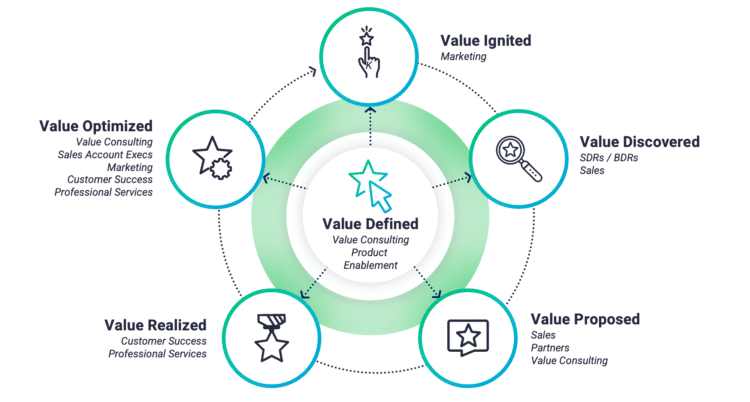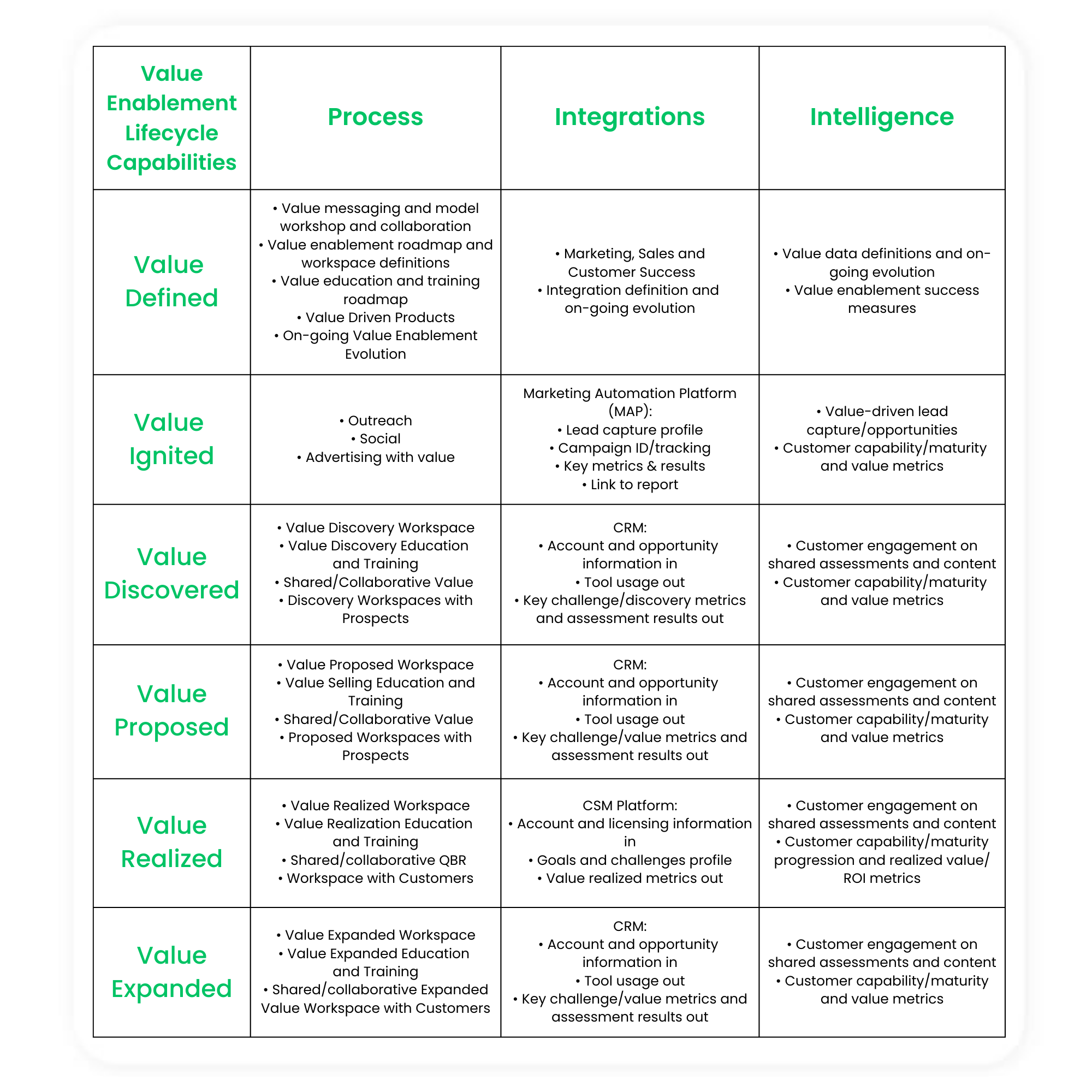So, you’re ready to move to value selling. You can see the sense in selling based on the value your solution brings to each customer, rather than wasting your customer’s attention on features and benefits that don’t speak to their needs. Value selling looks like the best way to serve your customers, and grow your business.
But how do you implement value selling? And how do you ensure all your customer-facing teams are aligned, so customers receive a unified, supportive, and (above all) useful experience? The answer is value enablement – aka the tools, resources, and processes that enable your marketing, sales, and post-sales teams to sell on value.
How Can My Organization Successfully Adopt a Value Selling Approach?
There are some wonderful value selling tools out there. Calculators that enable your customers to discover the potential ROI for themselves. Total cost of ownership tools. All of which make calculating value relatively straightforward.
But value enablement isn’t just about ROI calculations, and value itself isn’t necessarily as straightforward as 2 + 2 = 4, so you need more than just tools.
A value enablement program must be applied across the full customer lifecycle, from the very first customer touchpoint onwards. In order to achieve this, you need a framework within which you can all work, which is why Mediafly developed the Value Enablement Lifecycle. It’s a step-by-step guide to what (and who) you need at each stage of the customer journey in order to achieve a value selling approach, and as a result increase leads, win rates, deal size, retention rates and expansion revenue.
What is the Value Enablement Lifecycle?
The Value Enablement Lifecycle is a compilation of all the things that have worked for Mediafly, their customers and their partners to ensure success with value selling. By demonstrating what is needed at every touchpoint, the Value Enablement Lifecycle enables you to take all the good intentions behind your value selling approach and apply them at scale so that everyone benefits. Here, we’re going to run through each stage of the lifecycle, define the best practices, desired outcomes, challenges and useful tools, so that you can build the best value enablement program for your business.

Value Defined
The Value Enablement Lifecycle begins with and is centered around Value Defined. This ensures you have a solid foundation of value messaging, models, and tools to quantify value in a way that differentiates your business, builds trust, effectively captures great success stories, and drives value into your products. Bear in mind, Value Defined is not a static thing. You must regularly revisit and evolve the value messaging, models, and tools to match changing customer use cases and value trends.
What you can do
Define, develop, evolve and refine the value messaging, quantification models, interactive assessment tools, and success story evidence, while ensuring value program integration and success, and that products and services are added and evolved to drive better business value for customers.
Challenges
Getting this central component of your Value Enablement program right is essential. It’s the foundation for everything else. Remember to look to your existing customers to understand value – it may be that their impression of your solution’s value is different than yours. What is being realized? What is being reported? Is this changing over time? If there’s a trend in the evolution of value realized, can you include this in your definition of value to share with prospects and customers?
One of the real challenges of value enablement is scaling it across your organization. Factor this into your plans by defining the workflow, workspaces, and education/readiness needed to scale Value Enablement across all commercial organizations for both direct and indirect sales. How can you use tools to automatically convert customer intelligence into benchmarks, customer value success stories, and optimized customer value outcomes? For best results, track and measure the progress of your Value Enablement program, so you can see any changes that need to be made to optimize results.
Value Ignited
Value Ignited is the first customer touchpoint – what you might previously have called ‘Attract’.
What you can do
Marketing efforts should be focused on delivering value-focused content, interactive self-service diagnostic and value assessment tools, and value success stories. By providing customers with the ability to discover their challenges, self-assess their value potential and explore success stories, you can generate more closable opportunities while inspiring buyers to act. Leverage the discovery, proposed, and realized value data from across the Value Enablement Lifecycle to automatically develop and make use of Customer Value Success Stories.
Challenges
The challenge of value selling is communicating to each customer on a personal level. Personalized content speaks directly to each prospect’s unique opportunities and value perspectives.
In this stage, it is largely the responsibility of marketing to attract new prospects, especially higher-level/executive roles. With input from other teams, marketing must leverage new value-focused tools and content to power better outreach, social, and advertising campaigns. The result? More high quality, closable opportunities.
Value Discovered
With the leads captured, the Value Discovered stage is all about helping your customers see what they can get out of your solution. Use discovery and assessment tools to uncover and prioritize opportunities, prescribe the right solutions and services, and provide rapid value assessments to help prospects start thinking about value outcomes earlier in the decision-making process.
What you can do
Leverage dynamic value-focused content, interactive diagnostic and value assessment tools, and value success stories to help sellers engage earlier and at higher levels with value. We’re transitioning away from pitching products/services and demos to a more inspiring value-centric approach.
Challenges
In a competitive environment, the Value Discovered stage is a great opportunity to differentiate yourself from your competitors and convince prospects/customers of the added value your solution offers. Inspire prospects to engage with customized content and value-added tools, working on what you know about their challenges and needs to establish what value looks like to them. It’s important at this stage to qualify and prioritize prospects properly, so that you’re spending your precious selling time on those prospects that are most likely to close.
Value Proposed
Now that your prospects are growing more convinced of the value you’re selling, it’s time to develop collaborative value assessments and financial justifications for proposed solutions.
What you can do
Apply dynamic value-focused content, interactive value assessment tools, and value success stories to provide financial justification and value-proof points. You want to garner decision-maker consensus, faster executive and committee approvals, and make sure deals don’t end in “do nothing” or competitive losses.
Challenges
When you’re helping customers calculate the value of your solution, you need to give them credible business cases that not only prove outcomes but also differentiate you from the competition.
Don’t rely exclusively on value consultants to build and present these business cases on significant deals – you want your pre-sales specialists and sellers to be equally comfortable with and capable of effectively communicating and quantifying value and collaborating with prospects to make these business cases. Make sure you also empower partners to engage with value and deliver financial justification, not just direct sellers and specialists.
Value Realized
With value selling, the process doesn’t end with the contract. Value Realized is a post-sales process, in which you confirm and validate the value that has been delivered and realized by the customer. It is implemented to measure the actual impact of the deployed solution and services on key metrics and the value/ROI derived from these improvements.
What you can do
Use interactive diagnostic and value assessment tools to quantify advances in capability/maturity and realized ROI. Make comparisons with predicted value to understand potential deployment, adoption, and practice shortfalls. Automate the tally of realized value so that good customer success is documented in tangible Value Customer Success Stories.
Challenges
It’s easy to be simplistic about ROI, but as mentioned earlier 2 + 2 does not always equal 4. Sometimes the addition of your solution can have a much broader impact on your customer’s business than you imagined or even intended. If 2 + 2 leaves your customer with 10, that’s worth shouting about. Therefore, it’s important to go beyond measuring and reporting on adoption and usage, and instead report on and optimize value delivery for clients. Use a capability and maturity framework to measure and progress customers through a set of best practice improvements rather than just selling them on the latest release or additional products or services. You want them to get the most out of your solution, so they need to know how to use it properly.
With value selling, quarterly business reviews (QBRs) become an important opportunity to see how your solution is measuring up compared to predicted value. Provide executive reports on realized value/ROI and improved capability/maturity at each QBR, tracking progress in realized value/maturity and versus actual predictions over time. If a business case was provided pre-sale, validate the proposed value to ensure what was promised has been delivered.
Use tools and models to more easily quantify the value realized/realized ROI for all customers and scale this realized value assessment capability to make it easy to apply and adopt for all customer success reps or account managers, not just for value consultants/specialists.
Value Expanded
Now that you’ve proven the value of your solution and won the trust of your customer, we move into Value Expanded – an opportunity to up/cross-sell and grow the value of your customer.
Value Expanded uses realized value as a basis to grow the scope of solutions and services provided. Knowing what works for the customer, and where they need further support, you can perform value assessments to address additional business groups, solve additional challenges, and apply additional use cases.
What you can do
Use capability and maturity gap analysis and realized ROI results from Value Realized and apply dynamic value-focused content, interactive value assessment tools, and value success stories to help existing customers understand the value of expansion in up/cross sell use cases.
Challenges
Perhaps the biggest challenge here is to not get carried away. We’re aiming to sell what people need, not weigh them down with unnecessary add-ons that end up devaluing our business relationship.
Once you understand what those additional needs are and how you could deliver on them, you need to migrate from pitching additional products and services to selling additional capability/maturity and especially positive and tangible business value outcomes. This will enable you to better justify up-sell and cross-sell proposals. Leverage value delivered to prove that expanding the relationship could deliver even better outcomes.
Best Practices
We’ve discussed the tools/resources and teams required across every stage of the Value Enablement Lifecycle. The below table demonstrates the process, integrations and intelligence best practice you need to implement to succeed.

Ready to start your value selling journey? Learn more about the Value Enablement Lifecycle or contact us to speak to a value expert today.






Comments are closed.